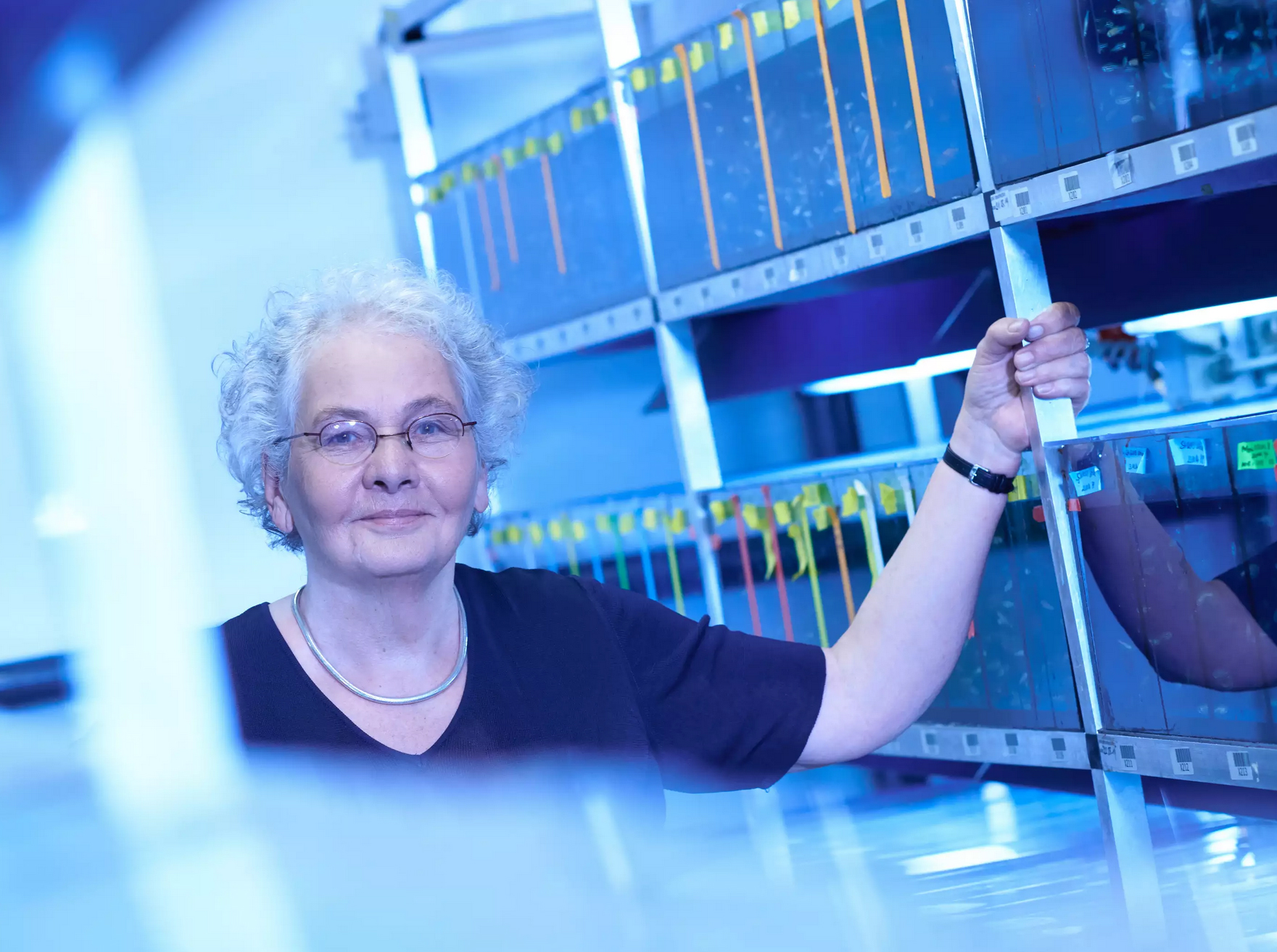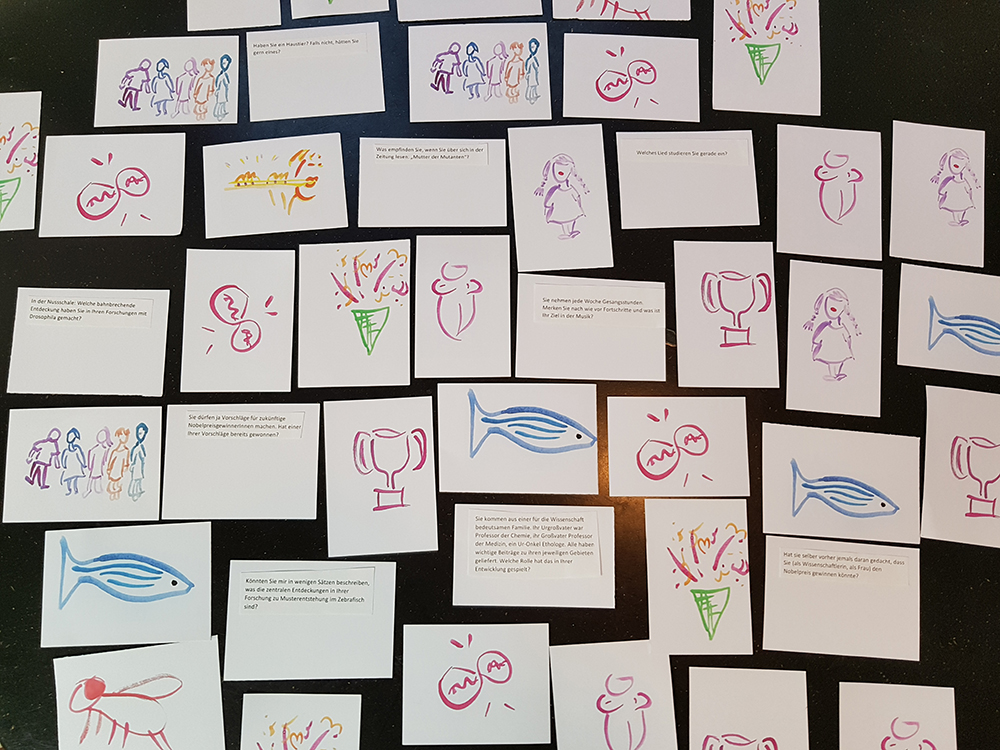Nüsslein-Volhard: “when there’s something that interests me, I tend to dive right in”
Nobel Prize winner Christiane Nüsslein-Volhard unveiled how an organism develops from an egg cell.
At 75, her curiosity is still unabated.  On first meeting Christiane Nüsslein-Volhard, what first strikes you is her inquisitive expression. Janni, as she is known by friends and colleagues, stands in the middle of her lab at the Max Planck Institute for Developmental Biology amidst hundreds of shimmering, blue aquariums each one the approximate size of a refrigerator vegetable bin. She taps on the glass of one, and the fish – spotted, striped, transparent, albinos – swim towards her finger. The longer you look at the fish, the clearer the differences. From an early age on, this researcher has possessed an eye for subtleties and a fascination for life’s mysteries.
On first meeting Christiane Nüsslein-Volhard, what first strikes you is her inquisitive expression. Janni, as she is known by friends and colleagues, stands in the middle of her lab at the Max Planck Institute for Developmental Biology amidst hundreds of shimmering, blue aquariums each one the approximate size of a refrigerator vegetable bin. She taps on the glass of one, and the fish – spotted, striped, transparent, albinos – swim towards her finger. The longer you look at the fish, the clearer the differences. From an early age on, this researcher has possessed an eye for subtleties and a fascination for life’s mysteries.
Her sister, Heidi List, reminisces that, as a child, Janni hoarded snails and kept them in a small cave-like enclosure, allowing them to compete against each other in races. Nüsslein-Volhard’s father, an architect, and mother, a kindergarten teacher, both encouraged her daughter’s scientific interest. The family lived in Frankfurt, Germany and fine arts were in the foreground of their home life. Her father painted, her mother played the piano, and all five siblings were involved with music. “Janni was thoughtful and shy,” List recollects. “As a young girl, she had already begun to develop a thick skin. She was especially sensitive as a child and felt vulnerable.”
Heidi always marvelled at how tenaciously her sister could devote herself to a task, be it solving a difficult puzzle or memorizing Goethe poems. In fact, when there’s something that interests her, Christiane Nüsslein-Volhard says that “I’m someone who tends to jump right in. When I was around 12, I was fascinated by Konrad Lorenz’s books on the behavior of animals and decided that I wanted to be a naturalist.
She first studied biology at the University of Frankfurt. There she fell in love with a young physics student, Volker Nüsslein. However, she became bored with her studies, and in 1964 she moved to Tübingen to study biochemistry. Volker soon followed her to Tübingen, where he continued his scientific work. Three years later, they married.
The beauty of mutations
After completing her doctorate in Tübingen, Nüsslein-Volhard set out to find a topic that delved into the essentials of biology. In doing so, she encountered developmental biology and one of its central unresolved questions: how does an ovum transform into a complex organism? Nüsslein-Volhard reasoned that if there were substances in the egg that determined how an organism developed, these factors must already be encoded in the genes. The young researcher’s idea expanded to the point where it linked two previously unrelated approaches: genetics and developmental biology.
For her research, she needed an animal in which genetic deviations, mutations, could be found relatively easily. Nüsslein-Volhard came across a paper on the fruit fly, Drosophila melanogaster. It described a bicaudal larva, a larva with two hindquarters. She realized this malformation could possibly indicate which genes controlled the division of the embryo in the front and back. Nüsslein-Volhard decided to figure out how to reproduce the mutation.
In 1974, Nüsslein-Volhard moved to the Biozentrum in Basel, Switzerland to join Walter Gehring’s research group and their work on the fruit fly. Her husband remained in Tübingen. She recalls her first time in Basel: „It was the kind of feeling an Egyptologist must have experienced when they first found an unopened grave. Everything that we tackled was fascinating.” She treated fruit flies with chemical substances that caused mutations, and then looked for eggs that did not develop properly. Within a half a year, she had isolated one of the most famous mutations to date, what she casually calls the „double rear-end“.
Under four eyes
At the age of 36, Nüsslein-Volhard had the opportunity to set up a laboratory at the European Molecular Biology Laboratory in Heidelberg. Because, as a woman, she was not trusted to be capable of setting up and running the laboratory by herself, the institute’s management insisted that Eric Wieschaus, five years Nüsslein-Volhard’s junior, come on board. This clear-cut discrimination turned out to be a lucky happenstance: the two turned out to be ideal working partners. Her long-distance marriage with Volker Nüsslein did not survive the strain, however, and the two divorced. Nevertheless, since she had already published under Nüsslein-Volhard, she retained the double name.
In the morning in the lab, she collected the freshly hatched female flies, and, using a glass tube, sucked out the rice grain-sized bodies, plopping them into a small container. She then assigned to each female a male for mating. Overnight, the female would lay about 50 eggs, and after two days, most of the larvae would hatch. What interested Nüsslein-Volhard was the period before the larvae hatched when they were still in their embryonic stage; what she was hunting for were development-inhibiting mutations. She prepared the eggs so that only the embryo’s transparent shell remained. Thus, under the microscope, the researcher could discern the structures of the embryo. She was searching for the shells that looked different and lacked segments.
For a year, day-in and day-out, Eric Wieschaus and Christiane Nüsslein-Volhard sat opposite each other at the lab table, looking through a dual microscope at the embryo sheaths. For Wieschaus, it was one of his strongest memories of their time together. It had the excitement of a competition: who could discover a mutation first? The work often went on into the night. In between, they would drive to dinner in Jannis’ Citroen „duck“, going to the „Bierhelderhof“ to eat Tafelspitz, a classic Bavarian meal of boiled beef, applesauce, and horseradish. Or they would end up at the „Hutzelwald“ eating Pilzpfanne, pan-fried mushrooms. In that year, the two developed an intense friendship based on mutual respect and a symbiotic work relationship.
Back then, many co-workers told her what she and Wieshaus were producing was rubbish. A Spanish colleague sarcastically stated that the immense amount of work the two put out was ‘typically German’. But so much hard work would eventually bring results. Almost forty years later, Nüsslein-Volhard still clenches her fists over the cavalier attitude of many of her fellow scientists during those early years.

To liven up the interview, I brought some question cards to the interview. They were supposed to cover different aspects of her life, for example, her childhood, her research, being a woman in science and winning the Nobel Prize.
Success with hedgehog and toddler
The success came quicker than expected. The two researchers identified a total of 120 genes that were necessary for the development of the fruit fly maggots’ body parts. They gave the gene locations such names as ‘hedgehog’ and ‘toddler’. In 1980, they published their results in the October edition of the prestigious scientific journal „Nature“.
Their paper described three significant gene groups. The gap genes provide for the division of the longitudinal axis of the embryo into segments. For example, a part of the middle section of the larva was missing from the mutated toddlers. In the case of the standard-pair genes, there was a disturbance (mutation) that caused a portion to fall out in every other segment of the gene. A mutation in group three, containing segment-polarity genes, such as hedgehog, the order within a segment became confused. Scientists also found these or similar genes in vertebrates and humans. Mutations in hedgehog-like genes in humans can lead to fatal malformations of the embryo and are also involved in the development of tumors.
After three years working together, Wieschaus returned to the US, and Nüsslein-Volhard received an offer to work as Director of the Department of Developmental Biology at the Max Planck Institute in Tübingen, Germany. She was now 43 years old; her success attracted young scientists from all over the world to Tübingen. However, her reputation as task-master also scared some of them off. Uwe Irion, who earned his diploma in an adjacent workgroup in the early 1990s, was warned not to go to the Janni lab because the work under Nüsslein-Volhard was extremely demanding. That did not deter him.
By the mid-1990s, more than 20 employees were working in Nüsslein-Volhard’s laboratory. She recalls that the women were less successful than the men. Some of the female scientists lacked motivation, which disappointed Nüsslein-Volhard. Possibly the disappointment was mutual. One female scientist working in Tübingen stated that some doctoral students complained that Nüsslein-Volhard preferred to deal with men.
However, Tatjana Piotrowski, who is now a researcher at the Stowers Institute for Medical Research in Kansas City, could not recall any favoritism. The trust that Nüsslein-Volhard had shown Piotrowski during her years in Tübingen had made her more self-confident; what she learned from Nüsslein-Volhard back then helps her in leading her own working group today.
In 1989, Nüsslein-Volhard decided to give her research a new spin. In addition to her continuing research on the fruit fly, she decided to study embryo development in a vertebrate, the zebrafish. Over the next years, there would be times her laboratory would house up to 7000 aquariums. This new approach also brought in a wealth of new insights; the scientific journal ‘Development’ devoted an entire issue on her team’s findings. In it, the researchers describe which genes were responsible for brain, muscle, and skin development in the zebrafish.
Her world changes
Nüsslein-Volhard had established herself as a key player in developmental biology. An article in the journal Science lauded her work as “a success of historical proportions, comparable to Magellan’s circumnavigation of the world.” In October 1995, Nüsslein-Volhard had just turned 53 years old. The phone rings and she receives the news that the world will learn about some 15 minutes later; she, together with Eric Wieschaus and Edward B. Lewis, has just received the Nobel Prize in Physiology or Medicine, and could she please call Eric Wieschaus, since, when the Nobel Prize committee had contacted him in America, he had seemed too drowsy to have comprehended what had just happened.
In some aspects, the following years seemed to pass by in a blur. The prize was followed by invitations, lectures, honors, and presidencies, including admission to the National Ethics Council of the German Federal Government. She writes several books, including a cookbook. “The cookbook was just too much,” says Janni. “It took up too much time and kept me from my research.”
In October 2017, Nüsslein-Volhard celebrated her 75th birthday. She still works a lot, only now, you rarely find her in the lab on the weekends. For the last twelve years, she has been dealing with a question that has long been regarded as of marginal consequence by the scientific community: how do the fish get their stripes? She received 2.2 million euros from the European Research Council to work on the project. She has uncovered the first mechanisms, published her findings in several science journals, and has recently prepared an illustrated booklet for laymen, “Schönheit der Tiere” (The Beauty of Animals). For Nüsslein-Volhard, retiring from research work is out of the question. Whenever she finishes a project, such as her new book, she ends up with a minor depression. Then she goes out in search of something new.
photo:
Nüsslein-Volhard – MPI für Entwicklungsbiologie
The text has been published in German in the Neue Zürcher Zeitung (2018)


